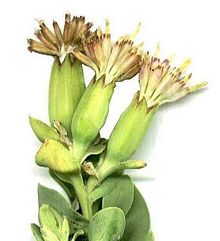Senecioneae
| Senecioneae | |
|---|---|
 |
|
| Lopholaena coriifolia | |
| Scientific classification | |
| Kingdom: | Plantae |
| Clade: | Angiosperms |
| Clade: | Eudicots |
| Clade: | Asterids |
| Order: | Asterales |
| Family: | Asteraceae |
| Subfamily: | Asteroideae |
| Tribe: |
Senecioneae Cass. |
| Genera | |
|
See text |
|
See text
Senecioneae is the largest tribe of the Asteraceae, or the sunflower family, comprising approximately 150 genera and 3,000 species. Almost one-third of the species in this tribe are placed in the genus Senecio. Its members exhibit probably the widest possible range of form to be found anywhere in the entire plant kingdom and include annuals, minute creeping alpines, perennial herbs, shrubs, climbers, succulents, trees and semi-aquatic plants.
Plants in this tribe are responsible for more livestock poisonings than all other plants combined. The poisons are particularly pyrrolizidine alkaloids in Senecio and furanoeremophilanes in Tetradymia.
A number of species are well known in horticulture.
Since the time of Bentham, the "premier systematic botanist of the nineteenth century" considerable efforts have been made to classify and understand the striking morphological diversity in Senecioneae. The traditional view of the tribe has been that of one huge genus Senecio plus many other genera which exhibit varying degrees of distinctiveness. Circumscription and delimitation of the tribe have experienced expansions and contractions over the decades as genera and groups of genera have been moved in and out, as was the case for Arnica, Liabum, Munnozia, , etc. which have since then been excluded. Of the several potential causes for this constant redefinition the greatest is probably that little is known about its intergeneric relationships or a lack of phylogenetic understanding enhanced by the other problems of conflicting clues from morphological characters, the large size of the tribe, the absence of a precise delimitation or circumscription of Senecio and the naturalness of these assemblages combined with the imprecise boundaries of the different species themselves.
...
Wikipedia
